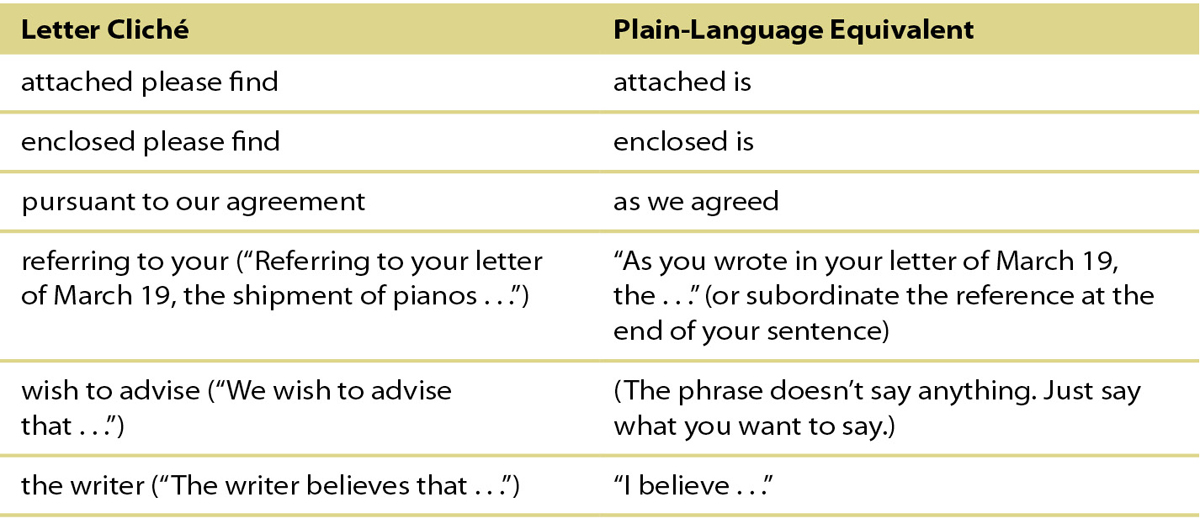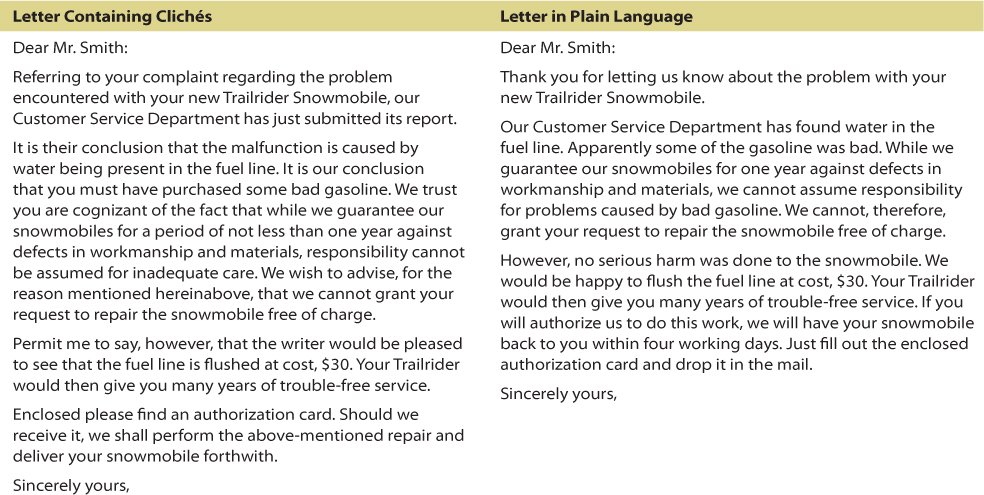Presenting Yourself Effectively in Correspondence
When you write business correspondence, follow these five suggestions for presenting yourself as a professional:
Use the appropriate level of formality.
Communicate correctly.
Project the “you attitude.”
Avoid correspondence clichés.
Communicate honestly.
USE THE APPROPRIATE LEVEL OF FORMALITY
People are sometimes tempted to use informal writing in informal digital applications such as email and microblogs. Don’t. Everything you write on the job is legally the property of the organization for which you work, and messages are almost always archived digitally, even after recipients have deleted them. Your documents might be read by the company president, or they might appear in a newspaper or in a court of law. Therefore, use a moderately formal tone to avoid potential embarrassment.
| TOO INFORMAL | Our meeting with United went south right away when they threw a hissy fit, saying that we blew off the deadline for the progress report. |
| MODERATELY FORMAL | In our meeting, the United representative expressed concern that we had missed the deadline for the progress report. |
However, you don’t want to sound like a dictionary.
| TOO FORMAL | It was indubitably the case that our team was successful in presenting a proposal that was characterized by quality of the highest order. My appreciation for your industriousness is herewith extended. |
| MODERATELY FORMAL | I think we put together an excellent proposal. Thank you very much for your hard work. |
COMMUNICATE CORRECTLY
One issue closely related to formality is correctness. Correct writing is free of grammar, punctuation, style, usage, and spelling errors. Correctness problems occur most often in email and microblogs.
Some writers mistakenly think that they do not need to worry about correctness because these digital applications are meant for quick communication. They are wrong. You have to plan your digital correspondence just as you plan any other written communication, and you should revise, edit, and proofread it. Sending correspondence that contains language errors is unprofessional because it suggests a lack of respect for your reader—
PROJECT THE “YOU ATTITUDE”
Correspondence should convey a courteous, positive tone. The key to accomplishing this task is using the “you attitude”— looking at the situation from the reader’s point of view and adjusting the content, structure, and tone to meet his or her needs. For example, if you are writing to a supplier who has failed to deliver some merchandise by the agreed-
Following are two examples of thoughtless sentences, each followed by an improved version that shows the “you attitude.”
| ACCUSING | You must have dropped the engine. The housing is badly cracked. |
| BETTER | The badly cracked housing suggests that the engine must have fallen onto a hard surface from some height. |
| SARCASTIC | You’ll need two months to deliver these parts? Who do you think you are, the post office? |
| BETTER | Surely you would find a two- |
A calm, respectful tone makes the best impression and increases the chances that you will achieve your goal.
AVOID CORRESPONDENCE CLICHÉS
For more about choosing the right words and phrases, see “Choosing the Right Words and Phrases” in Ch. 6.
Over the centuries, a group of words and phrases have come to be associated with business correspondence; one common example is as per your request. These phrases sound stilted and insincere. Don’t use them. Figure 9.1 is a list of common clichés and their plain-


COMMUNICATE HONESTLY
You should communicate honestly when you write any kind of document, and business correspondence is no exception. Communicating honestly shows respect for your reader and for yourself.
ETHICS NOTE
WRITING HONEST BUSINESS CORRESPONDENCE
Why is dishonesty a big problem in correspondence? Perhaps because the topics discussed in business correspondence often relate to the writer’s professionalism and the quality of his or her work. For instance, when a salesperson working for a supplier writes to a customer explaining why a product did not arrive on time, he is tempted to make it seem as if his company—
The professional approach is to tell the truth. If you mislead a reader in explaining why the shipment didn’t arrive on time, the reader will likely double-